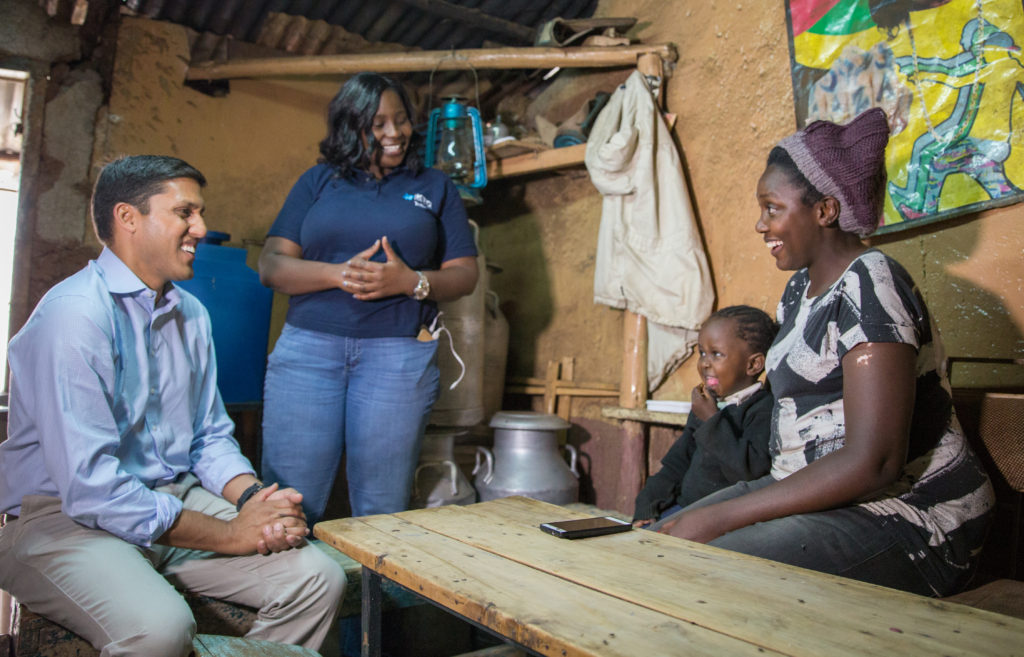 Olivia Leland has been at the forefront of two of the most notable global philanthropic initiatives, first at the Giving Pledge and now as founder and CEO of Co-Impact. Between them, they have prompted wealthy individuals and foundations to give more and differently.
Olivia Leland has been at the forefront of two of the most notable global philanthropic initiatives, first at the Giving Pledge and now as founder and CEO of Co-Impact. Between them, they have prompted wealthy individuals and foundations to give more and differently.
As she tells Alliance editor Charles Keidan, both initiatives are about far more than raising or distributing money. They are about creating the collaborative means to use it more effectively and create change at scale…
You were the founding director of the Giving Pledge. How did you become involved with that?
The Pledge came out of conversations that Bill and Melinda Gates and Warren Buffett had with philanthropists around the world on encouraging philanthropy. It was very much at the exploratory stage when I was at the Gates Foundation but I was tremendously excited by the potential, so I moved over to work on what a year and a half later became the Giving Pledge, going and talking to people and fleshing out the idea before we launched it.
Did the results exceed your expectations?
I remember Warren saying, ‘Even if we had ten or 15 families join the Giving Pledge that would be great’, and now it’s more than 170. More important than the numbers is the community it has created that is talking about how to make philanthropy more effective, because that was part of the idea from the outset. Not everybody needs to sign the Pledge, but, for those who do, by sharing their Giving Pledge letters and why they believe so strongly in philanthropy, it is creating a space for learning. The people who take the Giving Pledge are not only joining but also leading the effort by defining what’s needed for them to be more effective, because this is not an effort by Bill, Melinda and Warren, but something that is co-owned by everybody who takes the Pledge.

Giving Pledge founder Olivia Leland on a panel with Bill and Melinda Gates.
How did the conversations go around the world?
One of the very important things that came out was seeing the need to support more of what is happening around the world through a global effort, while recognizing local differences. In India and China, for example, there are amazing examples of philanthropists who are doing work that’s driving significant impact. Bill especially spends a lot of his time talking to philanthropists outside the US.
In terms of concerting philanthropic efforts, Co-Impact seems a logical extension of work you’d been doing on the Giving Pledge. How has Co-Impact developed so far?
The Giving Pledge is one aspect of creating greater impact through philanthropy. I was interested in what other infrastructure is needed and what we can do to support it. I was actually funded by Giving Pledge members to look into that, Jeff Skoll and Bill and Karen Ackman. I interviewed about 250 people around the world, mostly non-profit leaders, to ask what philanthropy could do to have more impact. Many of them, even the ones that have tremendous impact and proven models, said that they’ve reached only 1 or 2 per cent of the people that they could be reaching. I also found that there is a lot of research done on big bets and where can you really drive large-scale change, but if you’re a small family foundation or an individual philanthropist who doesn’t have a large team, working out where and how to intervene to support this is challenging. So the question was, how could we bridge that gap? While funding organizations is one critical piece, we recognized that if we really want to shift systems, it’s not going to be any one organization that will do it, so we need to collaborate.
That’s the premise of Co-Impact?
Exactly. Co-Impact will do two things – one is to significantly benefit millions of people around the world by supporting efforts in education, health and economic opportunity, and the second is, through the kinds of partnerships with other efforts that exist, to try to focus more philanthropy on large-scale change.

Bill and Melinda Gates with children at an Anganwadi centre in Bihar, India. Copyright: Gates Archive. Photo credit: Prashant Panjiar.
You’ve assembled a remarkable coalition of foundations and philanthropists, with a planned commitment of $500 million. How did you bring those together
From the exploratory stage to the launch was three years so a lot of it was about building the idea through input from many people. That was a key part of the design of Co-Impact. What I was particularly focused on was bringing together a group that would be really interested in collaborating with others to create effects on a large scale. In addition to our core partners, who will select the opportunities that we support, we also have the Co-Impact community, which is a much broader group of philanthropists who will support and engage with the opportunities and have a smaller financial commitment. We are also working to leverage Co-Impact’s financial contributions with support from other co-investors including other philanthropies, governments, multilaterals and business.
How do you become a core partner of Co-Impact? Do you need to have the money to make a financial commitment?
Yes, but it’s also about providing strategic guidance and serving on our advisory board. It’s important that this group be global, so we continue to expand it. We want to highlight more examples of truly great philanthropists from around the world, and a global group brings not just wider perspectives, but also greater reach and convening power.
It is notable that you have Indian philanthropists Rohini and Nandan Nilekani as a technical partner. How will that work
Nandan and Rohini Nilekani, along with their team at the EkStep Foundation, are doing some really exciting work around societal platforms to focus on the role of philanthropy and driving impact at scale. We are working with them to provide technical support to the initiatives in Co-Impact’s portfolio. This is part of our goal to provide a full set of non-financial support across the portfolio, based on what the initiatives suggest would be most useful to them in driving towards greater results.
You’ll soon be making your first grants. Can you give us a sense of what grants might be in the pipeline?
We’re making three kinds of grants. The first are ‘preparation stage’ grants. It takes a lot of work for initiatives to build a plan for enduring impact at system-wide scale, and to develop the kind of partnerships and support structure required. We provide some funding and technical assistance upfront to help them with this work. At the end of the preparation phase, our core partners will decide which ones to support with ‘systems change’ grants, and what magnitude of support to offer.
For each systems change grant, Co-Impact expects to award $10-50 million spread over a five-year period, and also provide a variety of non-financial support. It will be very important to partner with each initiative’s existing funders, as well as help to significantly advance and expand each initiative’s efforts to bring in additional funding, whether from philanthropy or from multilaterals and governments. Ultimately, the goal is to improve the lives of millions through advancing education, improving people’s health, and providing economic opportunity. Finally, over the course of Co-Impact’s lifetime, we will make a few ‘venture stage’ grants, which will be roughly $1-2 million for early stage but extraordinarily promising efforts in areas that are currently under-resourced, to help them build out and test their efforts over 2-3 years.
How many grants?
We will do several rounds of grantmaking over the next few years. For this round, I imagine it will be somewhere between two and four that are awarded the ‘systems change’ grants and then roughly similar numbers in each of the subsequent rounds. Ultimately, we’re expecting there to be around 8-12 of these full systems change opportunities.
At the moment, we’re focused on finding the opportunities. We are also focused on finding both financial and non-financial support, so we’re working with others to figure out how philanthropy can have the most impact in driving systemic change and how it can capitalize on examples and use them to identify others.
Co-Impact was incubated at The Rockefeller Foundation, where you were managing director, but you’ve chosen a US public charity, New Venture Fund, as the mechanism by which you distribute grants. What was your thinking?
New Venture Fund is our fiscal sponsor, which means that they receive and disburse the contributions from our donors. They also provide a lot of back office support for us in areas such as finance, human resources, and grants management.
What was behind that choice?
Two things. One is that we feel that it’s very important to create an independent space where all of the core partners can have equal voice. One of our core partners uses this evocative expression, ‘you don’t want to feel like the pimple on the tail of the dog’. I think that’s sometimes the case in philanthropy where you have these kinds of collaborations but don’t feel like you are equal partners.
The second is that, rather than creating a new entity, we can build on New Venture Fund’s tremendous knowledge and team and therefore be much more effective from the outset. We also have a special relationship with The Rockefeller Foundation in that it is incubating us, as you mentioned, and providing technical and strategic support, as well as covering our operations. I wear two hats in that I’m seconded to New Venture Fund as the CEO of Co-Impact and also spend a portion of my time advising The Rockefeller Foundation on collaborative philanthropy.
You’ve been praised for breaking new ground in large-scale, longer-term thinking, harnessing non-financial assets, bringing together peers, etc. Others, though, have suggested that your systems thinking terminology needs further exploration and doesn’t change underlying structures. What’s your response?
I hope we can bring actors together to create greater impact in the way we envisage. In terms of systems thinking, we’ve spent many months talking specifically about this. For me, the question of how we really drive systems change through philanthropy is more important than the definition. One of the things I kept hearing from people in the exploratory stage was that there’s so much discussion around systems change, but where’s the philanthropy to support it and learn what it takes to drive it? If we could bring philanthropy together to focus on this, on what it takes to address the root causes and on making sure the different voices are heard, then that would be a good thing.
Some people might perceive an initiative led by very wealthy philanthropists as elitist. What are you doing to make sure that the initiative reflects the people that you ultimately hope to benefit?

President of The Rockefeller Foundation Dr Rajiv Shah on a site visit to the Kibera Human Needs Project in Nairobi. Credit: @rockefellerfdn on Instagram
Two things. One is in the nature of the opportunities that we support. We are looking for things which involve a coalition of actors and which bring together different voices from across all sectors. The second thing is being quite conscious of elitism. We’re doing some work on engaging and getting feedback from the people that we’re seeking to serve – from our grantees, of course, and also from the communities they work with – and we’re exploring ways that we can make sure that we incorporate feedback throughout the work, not just in the evaluation, so that the initiatives can adapt to what they’re hearing.
Some grantmakers have begun to share power by bringing people that will be affected into decision-making roles. Can you at Co-Impact one day envisage some of the world’s poorest people sitting together with some of the world’s richest people to make decisions or does power have to remain concentrated among the richest?
How you ensure that you are hearing the voices of those affected needs to be a focal point of philanthropy. At the same time, philanthropy alone is a small piece of the puzzle, but we are able to sit at the table with partners and part of what we aim to do is to ask them those kinds of questions.
There’s a view even within philanthropy that it is the product of unjust systems. In seeking to change those systems, should philanthropy itself be subject to change?
I think this is a question that a lot of philanthropists ask themselves and I think this is a key thing that we can do – we’re not going to change all the power imbalances in society, but we can and should question them and philanthropists should be part of that process. But at the same time, the key question for me is what more can philanthropy do to really drive impact?
Charles Keidan is editor of Alliance magazine
Email charles@alliancemagazine.org Twitter @charleskeidan




Comments (0)